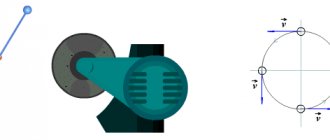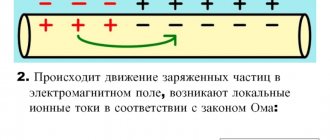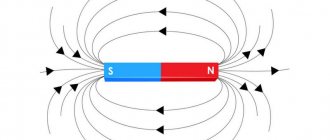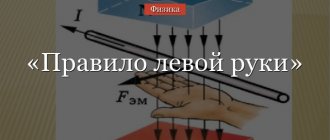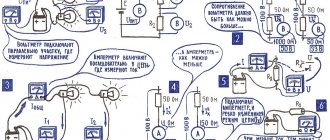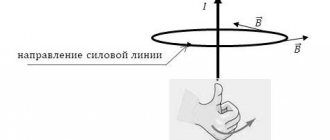To characterize rotational motion, in addition to angular velocity, the concept of linear velocity is introduced.
Linear speed is the speed at which a point moves around a circle.
The formula for the linear speed can be derived based on the following reasoning.
A point lying on a circle of radius R , in one revolution, will travel a path equal to the length of the circle 2πR a time equal to the period T. Taking the ratio of the path 2πR to the time T , we obtain the speed of the point moving around the circle:
v = 2πR/T
But 1 /T = n ; hence,
v = 2πRn
Relationship between angular and linear speeds
From here it is easy to establish a connection between linear and angular velocities. We already know that angular velocity is related to the number of revolutions by the formula: ω = 2πn ; therefore, based on the formula for the speed of movement in a circle, we obtain:
v = ωR
The linear speed of a point moving uniformly around a circle is equal to the angular speed multiplied by the radius of the circle.
It is known that the velocity vector of a point moving in a circle is directed along a tangent. Consequently, the linear velocity is directed tangentially to the circle.
From the formula it is clear that linear speed is measured in cm / sec , m / sec , etc.
Partial copying of articles is permitted with a mandatory link to the source
Corner path
To begin with, remember that linear displacement is the difference between the final and initial position of a point on an axis (Fig. 1).
\[ S = x – x_{0} \]
Rice. 1. Linear displacement is equal to the difference between the final and initial positions of a point on the axis
Let us now consider the wheel (Fig. 2). On the horizontal line passing through the diameter of the wheel, we will mark a red dot on the right, from which we will begin to count the angles. Let us agree to assume that near this point there is a zero angle.
Rice. 2. The point from position 1 shifted to position 2, passing an angular path
Select a point on the wheel rim, for example a nipple. At first, the nipple was at point 1. Point 1 is shifted by an angle \(\gamma_{1}\) relative to the origin.
We will rotate the wheel in the direction indicated by the blue arrow. Let's turn the wheel at a certain angle so that by the end of the movement the nipple moves to the point indicated by number 2 in the figure. This point is shifted by an angle \(\gamma_{2}\) relative to the origin.
By analogy with translational motion, the angular path that the nipple has traveled is the difference (difference) in the angular positions of points 1 and 2.
\[\large \boxed{ \varphi = \gamma_{2} — \gamma_{1} }\]
\(\varphi \left( \text{rad}\right)\) – the angular path is measured in radians.
The angular path is the angle through which the pin has rotated relative to its initial position.
Centripetal acceleration
When moving in a circle, the acceleration vector is always perpendicular to the velocity vector, directed towards the center of the circle.
Using the previous formulas, we can derive the following relationships
Points lying on the same straight line emanating from the center of the circle (for example, these could be points that lie on the spokes of a wheel) will have the same angular velocities, period and frequency. That is, they will rotate the same way, but with different linear speeds. The further a point is from the center, the faster it will move.
The law of addition of speeds is also valid for rotational motion. If the motion of a body or frame of reference is not uniform, then the law applies to instantaneous velocities. For example, the speed of a person walking along the edge of a rotating carousel is equal to the vector sum of the linear speed of rotation of the edge of the carousel and the speed of the person.
Frequency and period
Rotational motion is described using characteristics such as frequency and period.
The period of revolution is the time of one complete revolution. In the SI system, the period is measured in seconds.
\( T \left(c \right)\) – the time during which the body made a full revolution – period. Time is a scalar quantity.
Frequency answers the question: “How many full revolutions did the body make in one second?”
\( \displaystyle \nu\left( \frac{1}{c} \right)\) – rotation frequency, scalar.
Instead of writing \( \displaystyle \left( \frac{1}{c} \right)\) sometimes they use \(\displaystyle \left( c^{-1} \right)\), or \( \left( \ text{Hz} \right)\) – Hertz. This is the name of Heinrich Hertz, the famous physicist.
\[\displaystyle 1 \text{Hz} = \frac{1}{c} = c^{-1} \]
Frequency and period are related by inverse proportionality:
\[ \large \boxed{ T = \frac{1}{\nu} } \]
Connection to Newton's second law
According to Newton's second law, the cause of any acceleration is force. If a moving body experiences centripetal acceleration, then the nature of the forces that cause this acceleration may be different. For example, if a body moves in a circle on a rope tied to it, then the acting force is the elastic force.
If a body lying on a disk rotates with the disk around its axis, then such a force is the friction force. If the force stops its action, then the body will continue to move in a straight line
Circular movement - tasks
Task 1 . During a period of time c, the body has passed half a circle with a radius of 100 cm. Find the average ground speed and the module of the average speed.
Solution: the average ground speed is the average speed of the path, which we calculate by dividing the entire path (trajectory length) by the entire time. The average speed module is also called the average displacement speed. It can be determined by dividing the movement by time. Then the path length is the length of half the circle, and the displacement is the length of the diameter.
Answer: average ground speed – 0.314 m/s, average moving speed – 0.2 m/s
Task 2 . A homogeneous disk with a radius of 0.5 m rolls without slipping at a speed of 2 m/s. Find the speed of the disk points. Find the geometric location of all points on the disk whose speed is 2 m/s. Corner .
Speed of circle points
Solution:
Point A is the center of rotation. Therefore, its speed relative to the surface on which the disk is rolling is equal to 0. Since the condition says that the disk is rolling at a speed of 2 m/s, this means that its center will move at this speed relative to the surface: m/s. Therefore, point A relative to the center will move at exactly the same speed - at a speed of 2 m/s, and this will be the linear speed of rotation of the disk, that is, the speed of all points lying on its edge, relative to the center m/s. Linear velocities are shown for points with orange arrows. These arrows show what the speed of a given point would be if the disk did not roll, but rotated, for example, on an axis passing through its center. But our disk is rolling. Therefore, to the linear speed of rotation of each point it is necessary to add the speed of movement of the disk relative to the support. That is, to each red arrow we add (vectorally) the speed of point O - the center of the disk - a black arrow. Then it becomes clear why the point has a speed of 0 - the linear speed of rotation is directed to the left, and the rolling speed is directed to the right, and since they are equal, they cancel each other out: . At point C, on the contrary, the velocities will add up, since they are co-directional: m/s.
Let us now determine the velocities of points and . It is clear that they will be equal in number, but directed in different directions.
It remains to deal with the point. Let's make another drawing. The linear speed of rotation is always directed tangentially, that is, perpendicular to the radius. The angles that are formed between the vectors are shown in the figure, including the angle . Then in a parallelogram the angle is , and since
, then all the angles in the triangle are equal and it is equilateral, that is, m/s. It was also possible to find the length of this velocity vector using the cosine theorem or by adding the projections of the vectors. You can guess that a point symmetrical to point E relative to A also has a speed of 2 m/s. In general, points lying at the same distance from the center of rotation A will have equal speeds, lines of equal speeds (geometric locations of points with equal speeds) are shown in the figure with different colored arcs: a single point (point C) will have a speed of 4 m/s , points lying on the red arc will have velocities equal to , points lying on the blue arc will have velocities equal to 2 m/s, like point E.
Slipping
Task 3 . The wheel, slipping, rolls along a flat, horizontal road. Find the speed of the center of the wheel if it is known that the speed of the bottom point is m/s, and the speed of the top point is m/s.
Solution:
If the wheel slips, this means that the speed of its bottom point is not zero, that is, its center of rotation is not the point of contact with the surface, the center of rotation will be located higher. But the center of rotation is not in the center of the wheel. You can find it by drawing a vertical diameter, plotting the velocity vectors to scale, and then, connecting the ends of the velocity vectors with a straight line, marking the point of intersection of this line with the diameter. In our picture this is point O. Point K is the center of the wheel, and we need to find its speed. From the similarity of triangles we write down the ratios of similar sides:
Then
Then
Now let's turn to similar triangles and . For them, the ratio of similar sides is equal to:
Where is m/s from?
Well, a simpler solution would be if we simply found the arithmetic mean of the speeds, because the point that we are being asked about lies in the center between the points of application of the speed vectors and , and do not forget about the vector addition of speeds, we take the speed with a minus sign ":
m/s.
Answer: 4 m/s.
Slippage
Task 4 . The hoop, slipping, rolls along a horizontal, flat surface. At some moment the speed of the upper point A is m/s, and the speed of the lower point is B m/s. Determine the speed of the ends of the diameter perpendicular to for the same moment in time. At what angles are they directed to the horizon?
Solution:
Slipping is a situation when the speed of the bottom point (the point where the hoop touches the ground) is not zero, but it is directed in the direction of rolling. In this case, the center of rotation, just as in the case of slipping, does not coincide with the center of the wheel. Moreover, the center of rotation is not even inside the wheel - it is outside (point O). As in the previous problem, you can find it in the same way - by drawing a line through the ends of the velocities and finding its intersection with the extension of the vertical diameter. And, just like in the previous problem, we can determine the speed of the center of the wheel as the arithmetic mean, only both speeds are now directed in the same direction, so we put a plus sign in front of both:
m/s.
Since the speed of a point is the result of the vector addition of the linear speed of rotation of the wheel and the speed of translational movement of the center of the wheel, we can conclude from this that the linear speed of rotation is equal to 2 m/s - this is exactly how much the speed of the center of the wheel that we found differs from the speed of the point given in the problem statement. The linear speed was not shown in the figure, or was not shown everywhere. The velocities of the points and are numerically equal, but have different directions. Their speeds are also the result of the vector addition of the linear speed of rotation of the wheel and the speed of translational movement of the center, and since these two speeds are perpendicular to each other, the result of their addition can be found according to Pythagoras:
It is clear that since the velocities are perpendicular to each other, they are the legs of a certain right triangle, and the tangent function connects them to each other, therefore the angle of inclination to the speed horizon of the point can be found as
Answer: ,
A ball rolls along two lines
Task 5 . A ball of radius cm rolls uniformly and without slipping along two parallel rulers, the distance between which is equal to cm, and cm passes in time c. At what speeds do the top and bottom points of the ball move?
The figure shows how the ball moves, and for convenience, both a front and a side view are shown. Since the speed of the ball is equal to m/s, this speed is the speed of translational motion of its center of mass - point A. The center of rotation of the ball is at point O - at the level of the edge of the rulers. Let's determine the position of point O - determine the length of the segment. This is easy to do if you know the radius of the ball and look at the drawing from the triangle. The center of rotation is currently stationary, and point A is moving relative to it at a speed of 0.6 m/s. Therefore, the speed of the bottom point will be
In the same way we determine the speed of the top point:
Answer: the speed of the bottom point is 0.15 m/s, the speed of the top is 1.35 m/s.
Task 6 . A car moves along a curved highway with a radius of curvature m. The law of car motion has the form: , where m, m/s, m/s. Find the speed of the car, its tangential, normal and total acceleration at time c.
Solution.
Path:
Path derivative – linear speed:
Second derivative – tangential acceleration:
Normal acceleration:
Full acceleration:
Task 7 . The angle of rotation of a disk with a radius of cm changes with time according to the law. Determine the time dependences of angular velocity, angular acceleration and linear velocity of points on the disk.
Solution: angular velocity – derivative of the angle:
Angular acceleration is the derivative of angular velocity:
Linear speed:
Task 8 . A point moves in a circle with constant angular acceleration rad/. Find the angle between speed and acceleration 1 s after the start of movement. The initial speed of the point is 0.
Solution: since tangential acceleration and linear velocity coincide in direction, we will determine both components of acceleration: both normal and tangential. The angle between the total acceleration and its tangential component can then be found through the tangent function.
It is known that normal acceleration, tangential acceleration. At the same time, or. Then
Required angle:
Answer:
Two concentric wheels
Task 9 . Two concentric wheels with radii cm and cm rotate with angular velocities rad/s and rad/s, respectively. The third wheel is sandwiched between them as shown in the figure. What is the angular velocity of this wheel around its own axis? There is no slippage.
Solution: determine the radius of the small (third) wheel, m:
Let us determine the linear speed of the points of the first wheel:
Let us determine the linear speed of the points of the second wheel:
Let's find the angular velocity of the small wheel, knowing that the linear speed of its points is equal to the linear speed of the large wheels, since there is no slipping:
Answer: 20 rad/s
Problem 10 . The nut is tightened onto the bolt for a time. The length of the bolt, the thread makes an angle with the plane of the nut. Find the angular velocity of the nut if the radius of the bolt is .
The speed of rotation of the nut while screwing onto the bolt
Solution: when tightened, the nut not only rotates, but also moves forward along the bolt, for example, goes down. Therefore, a point taken on the edge of the nut will have two components of speed: the speed with which it will move down along the bolt (let’s call it ) and the speed with which this point rotates - this is the linear speed (already familiar to us). Then .
From the figure it is clear that
On the other hand, since the length of the bolt is , and the nut descends along it in time, then
Then
And you can define:
Then
Answer:
Speed module
The numerical speed value may vary depending on the selected unit of measurement. In addition to the numerical value, speed is characterized by direction. The numerical value that speed has is called its modulus in physics.
In the case when the speed has a certain direction, this quantity is a vector one. Thus, speed is a vector physical quantity. Write the velocity module as the letter v, and the velocity vector as \(\vec\)
It should be noted that quantities such as path, time, length have only a numerical value. They are called scalar. If the body moves unevenly, then it is fair to use the average speed in the calculations.
How to determine the kinetic energy of rotational motion?
the kinetic energy of a body during rotational motion is equal to half the product of the moment of inertia of the body relative to the axis of rotation and the square of its angular velocity.
Interesting materials:
How much does a real moonstone cost? How much do raw pearls cost? How much does it cost to study at the Faculty of Journalism at Moscow State University? How much is one euro worth in Russian? How much does one welding joint cost? How much does it cost to issue a plantain? How much does an original Picasso cost? How much does a holiday in Bali cost? How much does a pack of Contex condoms cost? How much does a pack of Winston blue cigarettes cost?
EXAMPLES OF TASKS
Part 1
1. When a body moves uniformly in a circle
1) only the magnitude of its velocity changes 2) only the direction of its velocity changes 3) both the magnitude and the direction of its velocity change 4) neither the magnitude nor the direction of its velocity changes
2. The linear speed of point 1, located at a distance \( R_1 \) from the center of the rotating wheel, is equal to \( v_1 \) . What is the speed \( v_2 \) of point 2 located from the center at a distance \( R_2=4R_1 \) ?
Mechanical movement and its types
Mechanical motion is a change in the position of a body in space relative to other bodies over time.
Mechanical movement can be: 1. by the nature of the movement
- translational is a movement in which all points of the body move equally and any straight line mentally drawn in the body remains parallel to itself;
- rotational is a movement in which all points of a rigid body move in circles located in parallel planes;
- oscillatory - this is a movement that is repeated in two mutually opposite directions;
2. by type of trajectory
- rectilinear is a movement whose trajectory is a straight line;
- curvilinear is a movement whose trajectory is a curved line;
3. by speed
- uniform - movement in which the speed of the body does not change over time;
- uneven is a movement in which the speed of a body changes over time;
4. by acceleration
- uniformly accelerated is a movement in which the speed of a body increases over time by the same amount;
- equally slow is a movement in which the speed of a body decreases over time by the same amount.
Interesting example
Let there be a certain planet that made one and a half revolutions in forty-two hours, while the weather station located on its equator covered a path equal to 50 thousand kilometers divided by an hour. It is necessary to determine the linear and angular velocities of the planet as it rotates around its own axis. In addition, calculate what a day is equal to and find the radius of the planet. At the same time, assume that the shape of the cosmic body is an ideal sphere.
To solve the problem, the number of revolutions should be denoted by the letter en: n = 1.5, and t is the time during which the planet completed them. The path that the station has traveled can be represented as a material point and taken as l = 50,000 km. You will need to find the linear and angular velocities. In addition, according to the conditions of the problem, you need to find a day whose length is equal to the period - a complete revolution of the planet around its axis.
In such a task, it is not necessary to convert the data into the SI system. You can use kilometers and hours, since the task does not require you to give an answer in accordance with SI, especially since meters and seconds are inconvenient to use.
The first thing you can find is the linear speed, equal to the ratio of the distance traveled to the time: v = l / t = 50000 / 42. Solving the fraction, the approximate result will be 1190 km / h. Now you can find the speed of the rotation angle. It is necessary to divide the angle by which the position of the point has changed by time. Since one full turn is 2p, one and a half turns would be 3p. Then the required speed will be equal to: w = φ / t = 3p / 42 = 0.22 rad/h.
A day, that is, the period of revolution, will be defined as the full period of rotation, which can be divided by the number of revolutions during this time. The formula for calculation will look like this: T = t / N. By substituting the values, you can find the required period. It will be: T = 42 / 1.5 = 28 hours.
It remains to calculate the radius, which is equal to the ratio of linear speed to angular speed: R = v / w. Since approximate values were written as answers, to prevent an arithmetic error, you should not substitute already found numbers. Therefore, it is better to substitute algebraic expressions. Then: R = (l /t) / (φ / t) = l / φ = 50000 / 3p = 5305 km. The problem is solved.
Rectilinear uniformly accelerated motion
Rectilinear uniformly accelerated motion is motion in a straight line in which the body moves with constant acceleration:
When moving with acceleration, the speed can either increase or decrease.
The speed of a body during uniformly accelerated motion is calculated by the formula:
During acceleration (in projections onto the OX axis):
When braking (in projections onto the OX axis):
The acceleration graph (acceleration projection) for uniformly accelerated motion represents the dependence of acceleration on time:
The acceleration graph for uniformly accelerated motion is a straight line parallel to the time axis. Graph 1 lies above the t axis, the body accelerates, \( a_x \) > 0. Graph 2 lies under the t axis, the body slows down, \( a_x \) < 0.
The speed (velocity projection) graph represents the dependence of speed on time:
The speed graph for uniformly accelerated motion is a straight line. Graph 1 is directed upward, the body moves uniformly accelerated in the positive direction of the OX axis, \( v_{0x} \) > 0, \( a_x \) > 0.
Graph 2 is directed downward, the body moves equally slow in the positive direction of the OX axis, \( v_{0x} \) > 0, \( a_x \) < 0,
Graph 3 is directed downward, the body moves uniformly accelerated against the OX axis, \( v_{0x} \) < 0, \( a_x \) < 0. From the graph of speed versus time, you can determine the displacement traveled by the body during the period of time \( t_2 -t_1 \). To do this, you need to determine the area of the figure under the graph (shaded figure).
Displacement during uniformly accelerated motion is calculated using the formulas:
Displacement in the \( n \)th second with uniformly accelerated motion is calculated by the formula:
The coordinate of a body during uniformly accelerated motion is calculated by the formula:
Uniform movement
Uniform motion is a motion in which a body makes equal movements in any equal intervals of time.
Speed during uniform motion is a value equal to the ratio of movement to the period of time during which this movement occurred:
Projection of the velocity vector onto the OX axis:
The projection of the velocity vector onto the coordinate axis is equal to the rate of change of a given coordinate:
Speed graph (projected speed)
The speed (velocity projection) graph represents the dependence of speed on time:
The speed graph for uniform motion is a straight line parallel to the time axis. Graph 1 lies above the \( t \) axis, the body moves in the direction of the OX axis. Graphs 2 and 3 lie under the \( t \) axis, the body moves against the OX axis.
Displacement during uniform motion is a quantity equal to the product of speed and time:
Projection of the displacement vector onto the OX axis:
Movement graph (movement projections)
The displacement graph (displacement projection) represents the dependence of displacement on time:
The displacement graph for uniform motion is a straight line coming from the origin. Graph 1 lies above the \(t\) axis, the body moves in the direction of the OX axis. Graphs 2 and 3 lie under the \(t\) axis, the body moves against the OX axis.
From the graph of speed versus time, you can determine the displacement traveled by the body during time \(t\). To do this, you need to determine the area of the figure under the graph (shaded figure).
The coordinate of the body during uniform motion is calculated by the formula:
The coordinate graph represents the dependence of the coordinate on time: \( x=x(t) \).
The coordinate graph for uniform motion is a straight line. Graph 1 is directed upward, the body moves in the direction of the OX axis:
Graph 2 is parallel to the OX axis, the body is at rest. Graph 3 is directed downwards, the body moves against the OX axis:
Problems with example solutions
Task No. 1
A body moves in a circle with an acceleration of 3 m/s squared. The radius of the circle is 40 meters. It is necessary to determine the linear speed of movement of the body.
Acceleration in this case will be normal. Based on this, the linear speed of a body can be determined using the formula:
Answer: linear speed is 10.9 m/s.
Task No. 2
The train moves uniformly. Within 4 hours he covers a distance of 219 kilometers. You need to calculate the speed of the train.
Based on the basic formula for calculating linear speed, we obtain:
Answer: the speed of the train will be 54.75 km/h or 15.2 m/s.
Task No. 3
The vehicle, powered by an internal combustion engine, covers a distance of 213 kilometers within 2.5 hours. It is required to determine the speed of the vehicle.
Using the equation for calculating speed, you can write the solution to the problem:
Answer: The speed of the vehicle is 85.2 km/h or 23.7 m/s.
- 12 January 2021
- 8 minutes
- 10 145
Too lazy to solve problems? Welcome to our telegram, where interesting and useful information is collected for students and more.

